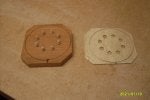I bought a Harbor Freight random orbital sander and returned it. It had too much vibration. The dust collection bag would lift during use and leak sawdust out the bottom of the gap, no matter what you did. The rectangular hole for the dust collection bag was not well-designed for attaching a shop vac or dust collector.
I returned it to Harbor Freight and replaced it with a more expensive Ridgid ROS from Home Depot. It sands slightly slower, but with far less vibration. The dust outlet fits my shop vac 2-1/4 inch hose, although I have noticed that it bends the two bayonet-mount pins for the dust bag, so now I use the inner 1-1/4 inch circular fitting with a stretchable rubber hose attachment - that works okay, but falls off occasionally.
When I bought the sander, I bought a collection of Freud sanding discs in various grits. They have 12 holes and fit both five hole or eight hole sanders. Four holes are large in a square pattern, the rest are smaller. Do an image search for "Freud sanding discs" and you can see the hole pattern. The extra holes probably mean less abrasive power than a true eight hole disc, but I bet that materials and workmanship (abrasive, glue, base) matter much more.
Someday I would like to try the Mirka Abranet sanding discs. They are much more expensive, but supposedly last much longer. The mesh material allows sawdust to flow without holes.
Dust collection with the Ridgid ROS and the Freud discs works very well with my shop vac, although I still wear a mask (and hearing protection for the shop vac).
My best and favorite sanding tool is a Preppin' Weapon sanding block. There are many reasons that I like it so much. Besides comfort and fit, it makes it so easy to change sandpapers. The top reason I like it is that it always sands with the grain.








